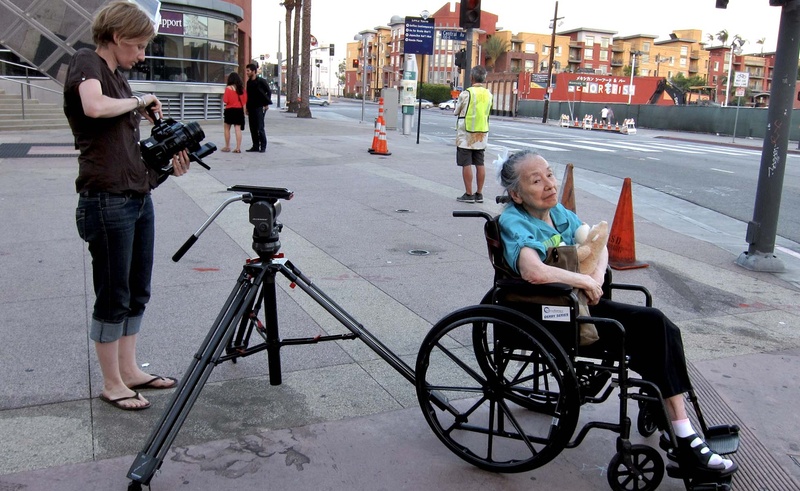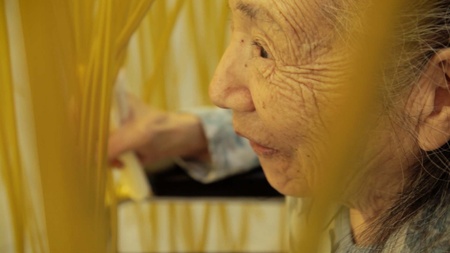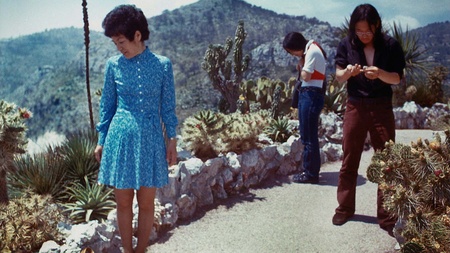TN: I’ve been starting to think about what it is to write memoir and I’ve really felt so strongly that you [the writer/narrator] are the portal to this larger thing but at the very least you have to get your audience, in your space, in your doorway before they get to these larger things but the better you can get the portal prepared for your audience, the better the connection is, the better the relationship is.
In another interview you talked a little bit about when you thought you realized you were making this film, and one point was when you were with your Temple [University] students, and they said, “your mom’s really interesting, you should make a film about her.” But I’m curious about when that was and then when were you like, “I am actually making this documentary about these things, caregiving, and my mom.” When did you commit to a larger project?
RT: So maybe like 2012 or 2011. I was doing these trips and then some of my students would say, “Oh wow, you need to film your mom.” I was starting to film her more seriously. And there’s this scene in the film where my mom decides to walk the perimeter of her assisted living at night. She’s like bored and I’m following her because in real life before she had dementia she loved to walk.
And so I thought well, okay, we’re going to walk together and we’ll walk these hallways. It was a very intense scene in a lot of ways because you really see that she’s walking through this place and everybody’s gone, they’re asleep, and she walks through this one room and she says, “hey, there’s nobody here.”
And then she finally sees this one guy in the kitchen…it’s a handheld tracking shot, that’s what they call it, so that’s what I was trying to demonstrate and, what I brought back to my students and they were like, “your mom is so interesting.” And that was encouraging. And I kept going back and I was starting to gather the footage in a more serious way.
And then I think I said OK around 2014, “I’m going to do it.” I started cutting things together and then I hired a DP [Director of Photography] for the day. And granted, I didn’t have a lot of money at all, and my tax refunds. I’d always take my tax refunds and [then] film.
And so I hired DP Christian Bruno. And my mom and I had gone to museums, and that became a thing. I realized this was a breakthrough in her care. I love going to museums, she loves going to museums.
At this point I can keep up on the shows that I want to see. I can bring her, she loves them, and she would have these amazing insights into the artwork that she was seeing. I loved that. So I thought all right, let’s try to film that. The next day, let’s film the doctor’s visit. (That particular doctor’s visit didn’t make it into the film.)
But anyway we went to the museum and we went outside, and then we saw this yellow streamers installation and it was just like, “should I go in, should I not, what’s going on?” And as we approached the perimeter there were all these mothers who were telling their kids “oh, let’s make room, look, somebody wants to come in, let’s welcome her.”
Being very motherly and great as mothers are, and they were telling the kids and the kids were like “okay,” and I pushed my mom inside and instantly, children were just like ahhhh, really really fascinated with her in this. I mean, totally unexpectedly she was like [makes awestruck face], and they were… this instant kind of connection.
You can’t even describe it because some of the kids weren’t even talking, some of them weren’t even verbal yet. But he [the little toddler in the film] knows. He said, walking up to her, walking like this, just…it’s unbelievable. He just had to touch her and she was delighted.
There are these [places] in Europe, there’s one in California where they pair elderly person with a young toddler, because there’s something about where they’re at. They complement each other’s cognitive ability, where one has you know been in the world and where the other one is just discovering the world, there’s that.
But there’s also this both of them being a little bit unsure on their feet, and somehow the little ones identify with that and they feel comfortable. And you know they don’t have to necessarily make sense [laughs], they’re just kind of on the same kind of threshold in terms of verbal communication so it’s a really great match…so this was one of those moments where that happened. I never really saw it as much as I did that day. It was like, oh my god. We just had a great time.
That installation is very magical because you really lose sense of time and space. We were in there for over an hour, and people were just running around, and it was really funny.
There were some [pretty big] Japanese journalists who happened to be there and they were loving what this was…so they… so they started filming her and taking photos as well, and it was just the funniest thing.
All these cameras are filming and the parents started filming it, and everybody was filming my mom and these kids, so I felt like oh my god, there were 6, 7, 8 cameras filming, I don’t know what happened to that footage. Somewhere in the world there is more coverage of this [scene].
That was the magic that happened that day. That was the day I would think, “we have a film. We can really do something with this footage.”
And there’s a lot of jumping off points to talk about. This was what I wanted. I didn’t want the standard, “oh my mother has dementia.”
I really wanted to show these kinds of experiences because I think if you’re happen to have someone who is, I think that even if someone is nonverbal I think bringing people to art—this is what I also researched—art does have this way of stimulating the brain and people do open up and do become more expansive.
TN: That’s a lovely part of the film, I think. It’s what art does, right?
So I have questions about like, what it was like growing up with the camera like that. You’ve talked about the role of the camera in your family life and I was wondering if you could say more about that.
Like, do you remember pictures of you taken all the time? and do you remember you first time taking pictures? or did you come to the camera later in life or were you like “I want to take some too”?
RT: I do remember. Ever since I was little my father [photographer Vince Tajiri] always had the camera. I do remember this one moment where I was really mad and I was having a tantrum and I was lying on the floor. And then all of a sudden I was crying and all of a sudden my dad was there with a camera. [laughter]
And then about a week later he comes home with this photo of me and I’m like [grimacing], it’s right at my level, and I’m like [face contorted into a wail] wahhhhh, and I’m thinking, “Really, what is that? What are you doing? Why did you take that picture of me?”
And you can probably go to a million places with that, but…whatever, okay. We just knew, or we would just be living our lives, and then at some point there’d be a slide show.
And we would see ourselves in these slide shows on the big screen going, “wow, ok, yeah.” There’s this sense of time that … it wasn’t instant reconnection, like ‘oh, right, that happened, we lived that.’ It’s probably why I’m so obsessed with memory.
And then there would be this mysterious element of just, all these finding images. Just everywhere. Sometimes I could be doing something, opening a drawer, and then “what is this image, why are these there?”
And I remember discovering a bunch of black and white photos, it was probably the body of work that my father put into this monograph that he tried to get published and then he kind of dropped it. It was all this stuff that we’re actually going to make a film with, there are these photos from the mid 50s.
TN: The Chicago ones, right?
RT: And I remember going, “Who are these people? Why are they there? Why are they dressed like that?” I have a sense that it really pulled me and it was this other fascination and then like nothing was explained. It was just this big mystery.
So those were very haunting to me, I think that’s why I love archives because I think that archives really do haunt me. And I really keep thinking, that find, that what is that, what is that connected to, who are these people, what’s that moment, what’s happening here?
And then there was another aspect where we realized we could kind of talk back to the camera. We don’t have to behave for the camera. We could do all these things, and act badly, for the camera.
Or try to subvert the perfect family photo, which my brother does, [in the film] you see him turning his back to the camera, like he’s in a Eagles/Beatles photograph, or I’m going like this [makes comic face], or trying to really mess with him, my father. And we would convey even sort of privately our moods and that would translate, right, you’d see these photos with this kind of face.
TN: This really leads nicely to my next question which is really about silence because as you were talking it sounded like so much was documented but very little was explained. Is that accurate?
In an interview with Brandon Shimoda you said that your family had very little heirlooms, that anything passed down was lost during incarceration.
RT: Yeah, I think that on my father’s side that they had a bunch of stuff that they locked up in their house. I think my grandmother was so overwhelmed. She was a single mom and she was being told, yeah, we’re going to go somewhere. What do you do? What do you do with this place, this stuff?
So she took this stuff that was connected to Japan, she put it in a closet, put a padlock on it, and I think my aunt said that she didn’t think that the people who were renting [the house] even paid the rent because why would they have to? And then the house of course from “History and Memory” disappeared, and we never saw that.
I think on my mother’s side too—she has this really interesting story about this giant photo of their grandfather, and she said, “You know, there was this big photo.” And I’m like, “oh what happened to that?” And it probably got lost.
I don’t recall that we have anything that survived except my uncle Shinkichi of course has this scroll he’s had translated, but I don’t think we have any formal heirlooms. So I was...yeah, I was hungry for those things.
© 2023 Tamiko Nimura









